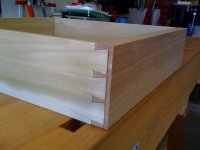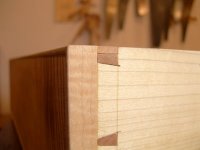I'm working on a pair of lamp stands and had planned on veneering and cockbeading the drawer fronts. I got ahead of myself when I cut the dovetails; you can see from the photo that my half pin left very little material (about 5/32") to rabbet for the cockbeading. Is this too thin to safely attempt? I intended to run a full-width bead at the top and bottom and 1/2 width cockbeads down the sides using stopped miters at the corners. I've managed to plane the cockbead down to about 3/32".
I may just redo the drawer with beefier DTs, but I'm curious to know how some of you have handled cockbeading drawer fronts, and what you've observed on period pieces.
Thanks,
Allan
I may just redo the drawer with beefier DTs, but I'm curious to know how some of you have handled cockbeading drawer fronts, and what you've observed on period pieces.
Thanks,
Allan


